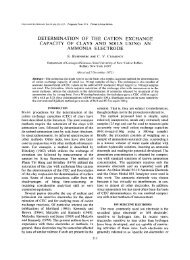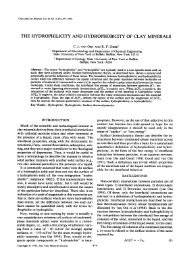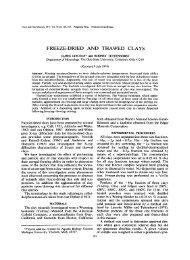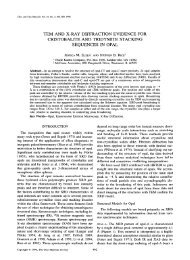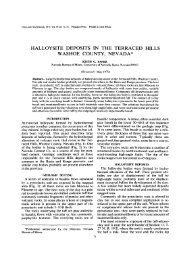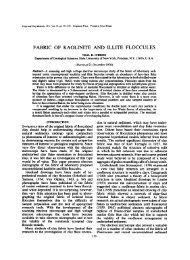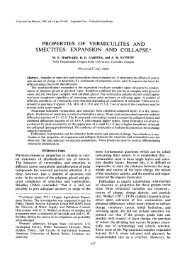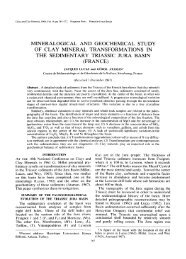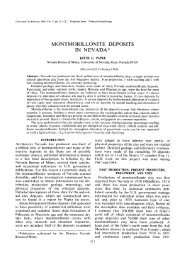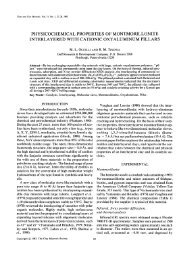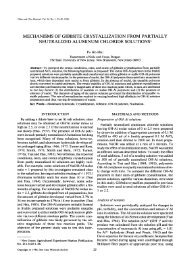formation of halloysite from feldspar: low temperature, artificial ...
formation of halloysite from feldspar: low temperature, artificial ...
formation of halloysite from feldspar: low temperature, artificial ...
Create successful ePaper yourself
Turn your PDF publications into a flip-book with our unique Google optimized e-Paper software.
FORMATION OF HALLOYS1TE FROM FELDSPAR 21<br />
Robertson, R. H. S. (1963) Allophanic soil <strong>from</strong> Trail<br />
Bridge, Oregon, with notes on mosaic growth in clay<br />
minerals: Clay Minerals Bull. 5, 237-247.<br />
Roy, R., and Brindley, G. (1956) A study <strong>of</strong> the hydrothermal<br />
reconstitution <strong>of</strong> the kaolin clays: Clays and<br />
Clay Minerals 4, 125-132.<br />
Roy, R., and Osborn, E. F. (1952) Studies in the system<br />
alumina-silica-water: in Problems <strong>of</strong> clay and laterite<br />
genesis: A.I.M.M.E. (New York) 76-80.<br />
Roy, R., and Osborn, E. F. (1954) The system AI20.~-<br />
SiO~-H~O: Am. Mineralogist 39, 853-885.<br />
Simonette, D. S., and Bauleke, M. P. (1963) Mineralogy<br />
<strong>of</strong> soils on basalt in North Queensland: Soil Sci. Soc.<br />
Am. Proc.27, 205-212.<br />
Sudo, T., and Takahashi, H. (1956) Shapes <strong>of</strong> <strong>halloysite</strong><br />
particles in Japanese clays: Clays and Clay Minerals<br />
4, 67-79.<br />
Uehara, G., lkawa, H., and Sherman, G. D. (1966)<br />
Desilication <strong>of</strong> <strong>halloysite</strong> and its relation to gibbsite<br />
<strong>formation</strong>: Pacific Sci. 20, 119-124.<br />
We yl, R. (1954) BeitrS.ge zur Geologie El Salvadors:<br />
Neues Jahrb. Geol. Palaeontol Monatsh. 49-70.<br />
Wolff, R. G. (1967)Weathering <strong>of</strong> Woodstock granite,<br />
near Baltimore, Maryland: Am. J. Sci. 265, 106-117.<br />
Wollast, R. (1967) Kenetics <strong>of</strong> the alteration <strong>of</strong> K-<br />
<strong>feldspar</strong> in buffered solutions at <strong>low</strong> <strong>temperature</strong>:<br />
G eochim. Cosmochim. ,4cta 31,635-648.<br />
Yoshinaga, N., Yotsumoto, H., and Ibe, K. (1968) An<br />
electron microscopic study <strong>of</strong> soil allophane with<br />
an ordered structure: ,4m. Mineralogist 53, 319-323.<br />
R6sum6-Les produits d'alt6ration par les intemp6ries form6s sur les surfaces du feldspath de<br />
potassium et de plagioclase (ANT0), qui ont 6t6 lixivi6es de mani6re continue darts un appareil d'extraction<br />
Soxhlet pendant 140 jours avec 7,21. d'eau distiU6e par jour h une temp6rature d'environ<br />
78~ sont morphologiquemcnt identiques aux produits naturels d6velopp6s sur des feldspaths de<br />
potassium alt6r6s par les intemp6ries dans des conditions de bon drainage dans une r6gion tropicale<br />
et humide. Les nouveaux produits qui aparaissent d'abord comme des protrub6rances de dimensions<br />
r6duites h la surface du feldspath commencent h se d6velopper surtout aux bords expos6s mais<br />
6galement de mani~re apparemment al6atoire aux surfaces plates de fente. A mesure que l'alt6ration<br />
continue, les protub6rances se propagent vers l'ext~rieur 5. partir de la surface du feldspath afin de<br />
former des projections effil6es, qui se d6veloppent ensuite en pellicules ou feuilles minces et 5. base<br />
large. Les feuilles minces d'un nombre 61ev6 de projections se fondent alors dans le sens lat6ral afin<br />
de former une seule feuille continue en forme de flamme. Les feuilles form6es sur les feldspaths de<br />
potassium peuvent alors s'enrouler pour former des tubes inclin6s en angle 61ev6 par rapport 5. la<br />
surface du feldspath. Des cavit6s de forme triangulaire sur le feldspath de potassium 5. alt6ration<br />
artificielle servent en tant que centres pour le d6veloppement de tubes continus, non-roul6s et creux.<br />
On suppose sur la base de sa morphologie que ce produit d'alt6ration est le <strong>halloysite</strong> ou une forme<br />
primitive de celui-ci. Le produit du feldspath de potassium 5. altO.ration naturelle est le <strong>halloysite</strong><br />
9 4 H~O.<br />
Les pellicules ou feuilles en forme de flamme form6es sur le feldspath de plagioctase 5~ alt6ration<br />
artificielle ne se d6veloppent pas en tubes creux mais donnent lieu 5. un min6ral sous forme de plaques,<br />
probablement le boehmite. Ces plaques se forment 5. l'int6rieur des pellicules sous forme de flamme,<br />
et 5. mesure que I'alt6ration continue, sont lib6r6es quand la pellicule se d6grade. Cette exp6rience ne<br />
tend pas h d6montrer la <strong>formation</strong> des formes de kaolinite pseudo-hexagonal sous forme de plaques 5.<br />
partir de ces min6raux lors du commencement de l'alt6ration.<br />
Kurzreferat--An den Oberfl~ichen von Kalium- sowie von Plagioklasfeldspaten (ANT0)gebildete<br />
Verwitterungsprodukte, die in einem Soxhlet Extraktionsapparat 140 Tage lang ununterbrochen mit<br />
7,21. destilliertem Wasser pro Tag bei einer Temperatur yon ca. 78~ ausgelaugt wurden, sind morphologisch<br />
identisch mit den Naturprodukten, die sich an Kaliunffeldspaten bilden, die in den feuchten<br />
Tropen unter guten Ablaufbedingungen, der Verwitterung ausgesetzt waren. Die neuen Produkte, die<br />
zun~ichst als winzige HiScker an der OberfD.che des Feldspates auftreten, entwickeln sich zuerst<br />
haupts~ichlich an den exponierten Kanten abet auch in scheinbar regelloser Anordnung an flachen<br />
SpaltoberflS.chen. Bei fortschreitender Verwitterung wachsen die H6cker auswS.rts vonder Feldspatoberfl~iche<br />
und bilden konische AnsStze, die sich sp~iter in diinne Filme oder Bl~ittchen auf breiter<br />
Grundlage entwickeln. Die diinnen Bl~ittchen zahlreicher Ans~itze vereinigen sich seitlich und bilden<br />
ein kontinuierliches, flammenf6rmiges Bl~ittchen. Die auf Kaliumfeldspaten gebildeten Bl~ittchen<br />
k6nnen sich dann zusammenrollen und formen ein in einem steilen Winkel zur Feldspatenoberfl~iche<br />
geneigtes R6hrchen. ,~tzgriibchen mit dreieckigen Kontouren auf den kfinstlich verwitterten Kaliumfeldspaten<br />
dienen als Ansatzorte fiir die Entwicklung kontinuierlicher, nicht gerollter Hohlr~ihrchen.<br />
Aus der Morphologie wird geschlossen, dass es sich bei diesem Verwitterungsprodukt um Halloysit<br />
oder um die Primitivform desselben handelt. Das Produkt des natiirlich verwitterten Kaliumfeldspates<br />
ist Halloysit 9 4H~O.<br />
Die flammenf/Srmigen Filme oder Bl~ittchen auf kiinstlich verwittertem Plagioklasfeldspat bilden<br />
keine Hohlr/~hrchen, sondern ergeben anstatt dessen ein PlS.ttchen, das hiSchstwahrscheinlich Boehmit<br />
ist. Diese Pl~ittchen bilden sich innerhalb der flammenf6rmigen Filme und werden bei fortgesetzter



